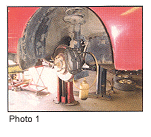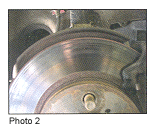Since the brake system is considered such an integral contributor to a vehicle’s safe operation, this article will take a look at maintaining and servicing the brakes and ABS system on the Toyota lineup of vehicles.
By now, you should have studied about the basic function of the anti-lock brake system. As the name implies, the system is responsible for preventing brake lock up. By monitoring individual wheel speed and brake application, the electronic control unit can control brake lock up using the hydraulic modulator to regulate the pressure to the wheel that is about to lock. Preventing this lock up increases the driver’s control of the vehicle, providing the opportunity to avoid an accident. Like air bags, ABS has been embraced by both the consumer and insurance industry as a safety enhancement. Once available only on the high-end of the Toyota vehicle line, you will now find ABS throughout its lineup.
Brake System Review
For the ABS system to function as designed, it is critical that the basic brake system is in top condition. Good service practices are always important when performing brake service. On vehicles equipped with ABS, they become critical.
If there is a weak link in the brake and ABS system, it would be the brake fluid. Toyota, like all other car makers, recommends periodic brake fluid changes. If the shop you someday work at isn’t suggesting brake fluid changes, they’re missing out on an opportunity to sell a profitable service that’s also a good value for the customer. Changing fluid is as important to the brake system as oil changes are to the engine. For customers who understand the value of an oil change, it should be an easy sell.
At the very least, you should flush and bleed the system when replacing the pads. It shouldn’t add much to the invoice since you already have the bleeders open. Gone are the days when you lower the fluid level in the master cylinder reservoir and push the fluid back from the caliper. Only a tiny piece of grit can plug up the orifices located in the modulator. It’s much safer to open the bleed valves and catch that dirty fluid in your bleeder bottle (see Photo 1).
 Passing Inspection
Passing Inspection
While performing the brake service, look at the wear on the old pads as they are removed. If the pads aren’t worn equally, now is the time to find out why. A brake that is dragging or not applying properly will not only hamper proper operation of the ABS, but it will definitely affect the quality of the brake service. It shouldn’t be difficult to find the cause of the uneven wear. Mechanical problems, like frozen slider hardware or pads jammed in the brackets, will be obvious as you perform the service. Be sure to clean and lubricate all the hardware, as well as the pad bracket, to ensure a high-quality job.
Problems with calipers won’t be as obvious. With the amount of effort normally required to push the piston into the caliper, you may not be able to pick up a questionable caliper. Look at the rotors for signs of overheating. If the caliper is hanging up enough to cause premature pad wear, there should be evidence of overheating on the pad or rotor (see Photo 2). When faced with a bad caliper, I recommend replacing both calipers on that end of the car. Since most sticking calipers are caused by lack  of fluid changes, it’s a safe bet that the bores in the other calipers are in the same shape as the one that is sticking. No special procedures are required to bleed the brakes on most ABS-equipped Toyota cars. But it always pays to check the service information. If you’re working on a truck or SUV, also be sure to review the procedures that apply to those vehicles.
of fluid changes, it’s a safe bet that the bores in the other calipers are in the same shape as the one that is sticking. No special procedures are required to bleed the brakes on most ABS-equipped Toyota cars. But it always pays to check the service information. If you’re working on a truck or SUV, also be sure to review the procedures that apply to those vehicles.
Welcome to the ECU
Like all computer-controlled systems, the ABS system is controlled by an electronic control unit. This ECU receives inputs from various sensors. Using this input, the output side of the ECU controls the ABS modulator, preventing the wheel from locking up. This modulator, which all the brake lines pass through, houses the solenoids and pump that are necessary to perform that function. On the input side of the ECU, you’ll find signals from the wheel speed sensors, hand brake and stop light switches.
Since the brake system will operate as normal until the ABS is called upon, most of your customers’ complaints are going to be that the ABS lamp on the dash is illuminated. The lamp should light for a couple of seconds when the car is started to check the bulb, then it will go out. Certain faults will cause the lamp to stay lit from the time the key is turned on. Other functions will be checked once four mph is reached. If all is well, the lamp will remain out. If a fault is evident, the lamp will light and the system will not operate. Some customers may notice a noise coming from the modulator during the self test. Assure them that this is normal.
Retrieving the codes requires no special tools, although good service information is critical. In this article, we’re going to look at a mid-’90s Toyota Avalon that came in with no complaint other than the lamp being lit. All the models use the same procedure for retrieving and clearing codes, but code definitions are dependent on the system used in the vehicle. Toyota has used both Nippondenso and Bosch systems. The systems are similar, with the biggest difference being that the ECU is part of the modulator on the Bosch system, while the Nippondenso system uses a separate ECU mounted in the car (see Avalon modulator, Photo 3).
Retrieving Codes
On an Avalon, we had some trouble retrieving codes and discovered that the problem was with our service information. The scanner suggested one method of retrieval, while our service information suggest another. We actually ended up using both sources.
You can access the codes using the diagnostic link connector. There are two on most late-model Toyotas – there’s the familiar rectangular box under the hood, as well as a second round connector mounted under the dash. We used the underhood DLC.
We got Codes 38 and 39 on this Avalon. Those codes represent an open circuit in both rear wheel sensors. Bad wheel-speed sensors are not unusual, but getting codes for both is! There are 17 codes available for the system in this mode, eight of which deal with wheel-speed sensors. The system will detect opens in the sensors as well as set a more obscure code. Codes 31 through 34 give a simple malfunction code, but do direct you to the problem sensor for further testing.
The most challenging part of the testing procedure is getting to the connector to perform the test. To access the front sensors, you’ll have to loosen the inner fender panel. On the rear, it will be necessary to remove the rear seat cushion to access the connector. Using your DVOM with the sensor disconnected, check the resistance of the sensor by connecting the leads of your meter across the sensor terminals. Also check each terminal to a chassis ground to look for a short-to-ground. Check the specs, but if it shows open or shorted, you will need a new sensor.
If the resistance test is good, set your meter to AC voltage or, if available, frequency. If you have a lab scope or graphing meter, this is the time to use it. Connect the leads of your meter to the sensor and spin the wheel. You’re looking for an AC voltage or frequency; the amount will be dependent on the speed of the wheel. Your graph reading should be a nice, smooth wave with no drop outs. By looking at the waveform, irregularities in the speed sensor ring will be evident. If you are in doubt, compare your readings with another wheel that hasn’t set a code. Don’t forget that tire size is critical to wheel speed. An oddball tire will have you chasing your tail for sure. If the wheel-speed sensors check out, and the code persists, access the ECU and check your inputs. Of course, if you have a good signal at the sensor and not at the ECU, there’s a harness problem.
The other codes relate to the solenoids, pump and their relays. The solenoids and pump are housed in the modulator. The pump’s function is to make the necessary pressure for the solenoids to control brake application when needed. When working with diagnostic codes, remember they are circuit-specific. If you get a code for a shorted solenoid, make sure the solenoid is, indeed, bad. All the ECU knows is that the circuit is shorted. Don’t replace an expensive part, only to find out that you have a problem with the wiring. Toyota products have very few problems with both ECUs and modulators. I would double- and triple-check any diagnosis that has me replacing either of these parts. There are no service parts available for the modulator.
Back to our Avalon that produced an open sensor code at both rear wheels. An initial visual inspection didn’t show anything unusual. We did make note that the car had new rear struts. The rear seat cushion was removed to get to the sensor connectors. It didn’t take long to confirm that we had two open sensors. Looking again, there was no damage to be found on the lead going to the sensor.
The sensor and the bolt that secures it are easy to get to, and the sensor came right out of its mounting hole. That may not always be the case, as some of these sensors can be stubborn, depending on the age of the vehicle and the rust factor. Tough cases will have you removing parts to drive the sensor out of its bore. When faced with this problem, take the time to clean out the hole. Not only is it important that the new sensor is all the way in to achieve the proper air gap, but trying to force the new sensor into the hole will certainly damage it.

With our sensors on the bench, we were able to remove the outer protective tubing and found that both leads were broken where they connect to the sensor. I suspected that the wires were damaged when the struts were replaced (see Photos 4 and 5). The customer confirmed that the ABS lamp had been lit since the strut job. It’s too bad that the technician doing the struts didn’t think to put slack in the wiring. In this case, it cost his shop a customer, and the shop’s reputation also took a hit. And, not so much because a mistake was made, but how it was handled. Two new sensors on our Avalon straightened out the problem and got us a new customer.
Final Thoughts
This article won’t make you a Toyota ABS expert, but hopefully, it will give you the confidence to take on the Toyota ABS problems that find their way to you. There is no reason you shouldn’t be able to tackle these jobs, with solid skills and good information on your side.


